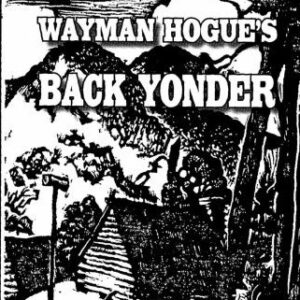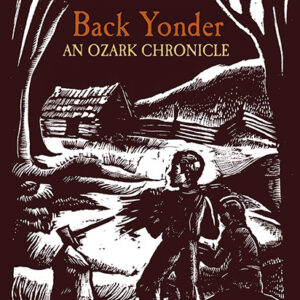calsfoundation@cals.org
Back Yonder, An Ozark Chronicle
Back Yonder, An Ozark Chronicle, published in 1932, is the autobiography of Charles Wayman Hogue (1870–1965), who grew up in Arkansas’s Ozark Mountains. Arkansas folklorist Vance Randolph wrote that Back Yonder was, “One of the finest nonfiction books ever written about the Ozark country. Hogue is a native of Van Buren County, Arkansas. He knows the truth about this region, and sets it down without any sentimental twaddle.” Hogue was the father of well-known Arkansas author Charlie May Simon. Her second husband, Howard Simon, illustrated Hogue’s book with exquisite woodcuts.
As a young man in his early twenties, Hogue left the Ozarks to attend Little Rock University (now the University of Arkansas at Little Rock). It was there that he realized that his Ozark dialect was holding him back, and he taught himself standard English pronunciation. He then accepted a teaching job in Drew County, where he met his wife, Mary Jackson Gill. They later lived in Greenville, Mississippi, and Memphis, Tennessee.
Back Yonder covers the first twenty-five years of Hogue’s life and is unique in hill-folk literature partly because, unlike many writers of the day, Hogue had a knack for using mountain dialect convincingly. In the foreword, Hogue states that he quoted conversation exactly as he had heard it spoken and as he was taught to speak it. The book preserves stories of brush arbor meetings, the mourner’s bench, sitting up with the dead, public hangings, shape-note singing schools, square dances, play parties, subscription schools, house raisings, and debates (using Robert’s Rules of Order) on such topics as, “Which is more useful to mankind, the Broom or the Dish-rag?”
The New York Times published a full-page book review of Back Yonder with three woodcuts by Howard Simon. The reviewer described it as “a chronicle as engrossing as it is refreshing. It is a ‘slice of life’ that is as rich in its fundamentals as it is inarticulate of graces.” The Arkansas Gazette called Back Yonder “an unvarnished tale. There is no sentiment, no artificial color no defending them for any of their shortcomings, no straining for atmosphere…and no apology for the people of whom he writes.”
Back Yonder was revived in an annotated edition in 2004 and republished by the University of Arkansas Press in 2016 with a new introduction by historian Brooks Blevins.
For additional information:
Dillard, Tom. “Writer Gave Us Late-1800s Ozarks Life in Rich Detail.” Arkansas Democrat-Gazette. September 26, 2004, p. 5H.
Guilds, John Caldwell, ed. Arkansas, Arkansas: Writers and Writings from the Delta to the Ozarks, 1541–1969. Fayetteville: University of Arkansas Press, 1999.
Hogue, Charles Wayman. Back Yonder. Annotated edition. Edited by Jody Parsons. Bella Vista, AR: The Back Yonder Company, 2004.
———. Back Yonder, An Ozark Chronicle. Edited by Brooks Blevins. Fayetteville: University of Arkansas Press, 2016.
Hutchinson, Percy. “The Hill-Folk of the Ozarks.” Review of Back Yonder, An Ozark Chronicle, by Charles Wayman Hogue. New York Times Book Review. April 10, 1932, pp. BR1, BR5.
McConnell, Carolyn Cherry. “Back Yonder.” Arkansas Gazette. March 6, 1932, pp. 5–6.
Jody Parsons
Bella Vista, Arkansas
 Early Twentieth Century, 1901 through 1940
Early Twentieth Century, 1901 through 1940 Back Yonder, An Ozark Chronicle
Back Yonder, An Ozark Chronicle  Back Yonder, An Ozark Chronicle
Back Yonder, An Ozark Chronicle 




Comments
No comments on this entry yet.